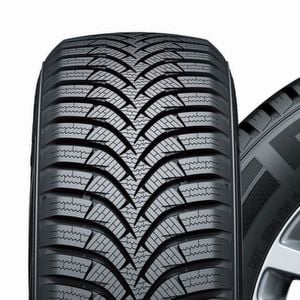Last Updated on 26.09.2024 by hrushetskyy

Imagine this! You’re about to go out for a drive on a beautiful sunny day, and you turn on your engine and start to drive, but no, what’s this? Your car AC is blowing hot air! Driving on a scorching summer day or a humid afternoon can be unbearable without a working car AC to cool you down. Your car’s air conditioning system is a marvel of engineering that keeps you cool and comfortable. But what happens when it goes wrong? Read on to learn why you might be getting hot air from your AC and what you can do about it.
How does my car AC work?
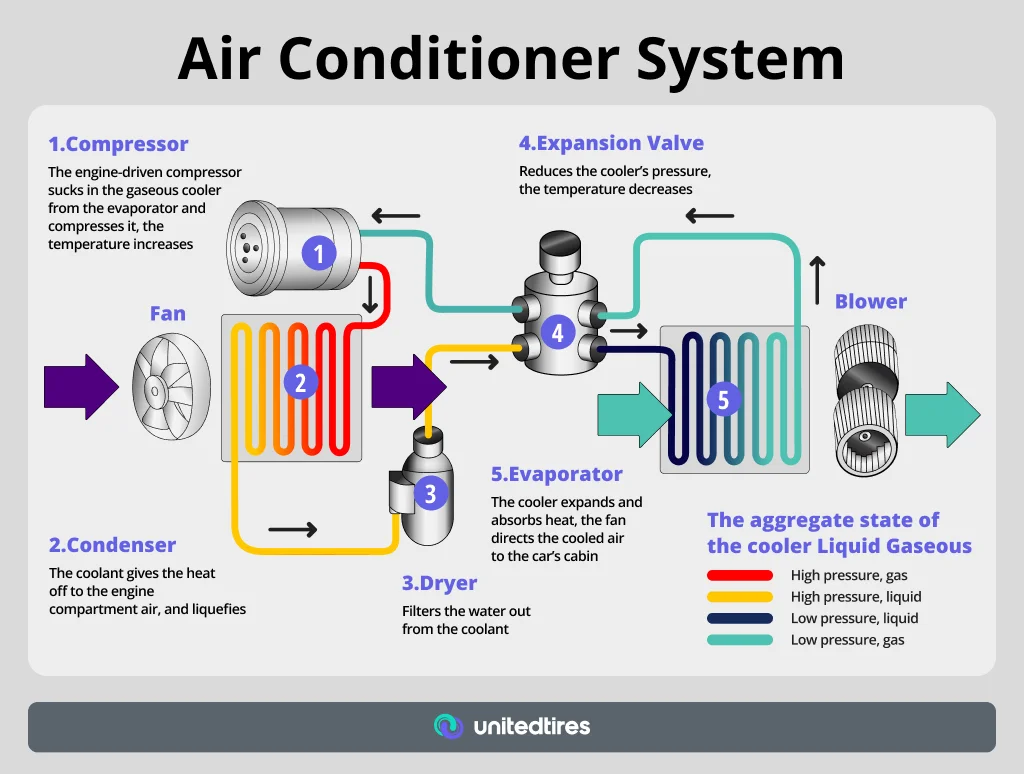
Before we get into the reasons why your AC might be blowing hot air it’s important to understand how your car air conditioner works. So let’s look at all the vital components that turn hot air into cool.
Compressor
Think of the compressor as the heart of your car’s AC system. This vital component is a pump designed to compress and circulate refrigerant gas. Its job is to draw in low-pressure, low-temperature vapor from the evaporator, compress it into high-pressure, high-temperature vapor, and push it into the condenser. Driven by the engine’s crankshaft via a drive belt, the compressor has an electromagnetic clutch that engages to start the cooling process.
Condenser
After leaving the compressor, the high-pressure vapor heads to the condenser, which you’ll usually find in front of your car’s radiator. Here, the hot vapor cools down and changes back into a high-pressure liquid. The condenser’s coiled tubing and thin cooling fins facilitate maximum heat transfer, which means they dissipate the heat absorbed from the passenger compartment and expel it into the outside air.
Receiver/drier
Next up, we have the receiver/drier, which stores the liquid refrigerant that comes from the condenser. It contains a desiccant bag that absorbs moisture and unwanted particles from the refrigerant, keeping the system clean and efficient. This cleanliness is crucial to prevent clogging in other parts of the system, like the expansion valve or orifice tube.
Evaporator
The evaporator is found on the low-pressure side of the system, where it removes heat from the passenger compartment and reduces humidity. As the low-pressure liquid refrigerant flows into the evaporator, it absorbs heat from the cabin air, causing the refrigerant to boil and change back into vapor. This process not only cools the air but also removes moisture, which exits through a drain. Removing moisture also helps your car feel cooler.
A/C control ECU
If the compressor is the heart of the system, then the A/C control ECU is the brain, managing and coordinating how all the various components work together. In some advanced systems, it even ties into the vehicle’s navigation system, adjusting the temperature settings based on factors like the vehicle direction, sunlight intensity, and ambient temperature. It does this so you always feel comfortably cool without ever having to adjust your air conditioner settings.
Potential AC problems and how to identify them
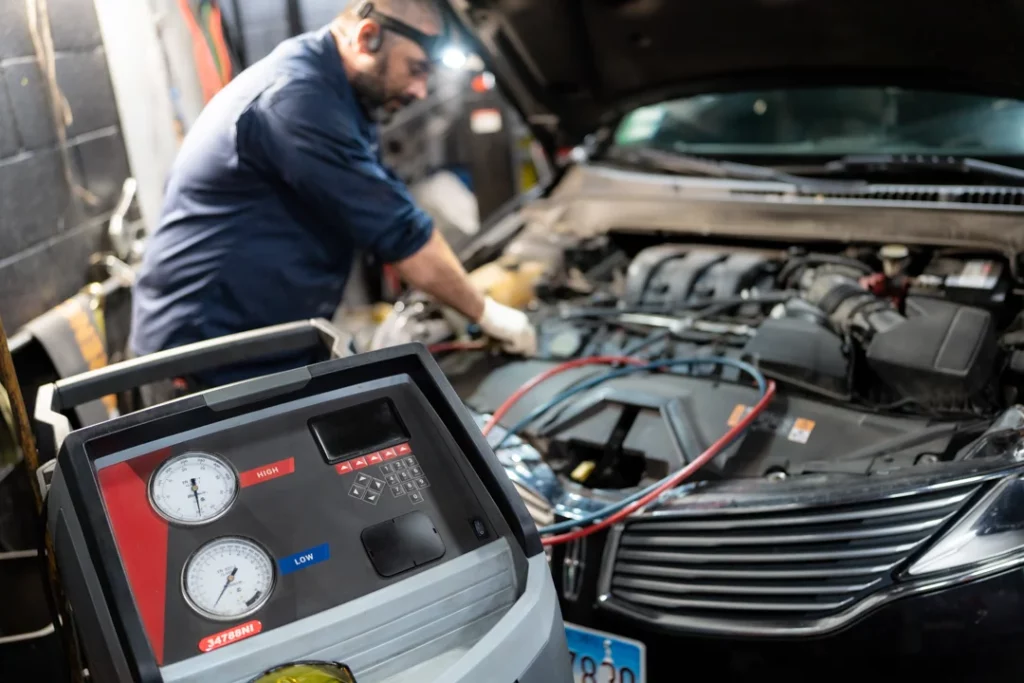
Expecting a refreshing breeze from your car’s AC only to be met with vents blowing hot air is frustrating. So, now that we understand how your car’s air conditioner works, we can look at some of the issues you might encounter and what signs and symptoms you might notice for each problem.
Refrigerant leaks
Refrigerant is the lifeblood of your car air conditioning system circulating through the components to absorb and dissipate heat. If you have leaking refrigerant, your AC can’t maintain the necessary pressure levels, making cooling ineffective—like trying to cool a room with a fan that has no blades.
Some of the main signs and symptoms of a refrigerant leak include:
- Chemical smell: You might notice a sweet or chemical odor when the AC is running.
- Weak cooling: The AC might start cool but quickly turn warm.
- Visual clues: If you see oily spots or a buildup of dirt around fittings, this often indicates a refrigerant leak.
Because refrigerant absorbs heat, it’s crucial for cooling down your car’s interior. This means that a refrigerant leak leaves you without enough refrigerant to cool the air, leading to ineffective cooling.
Broken or dirty condenser
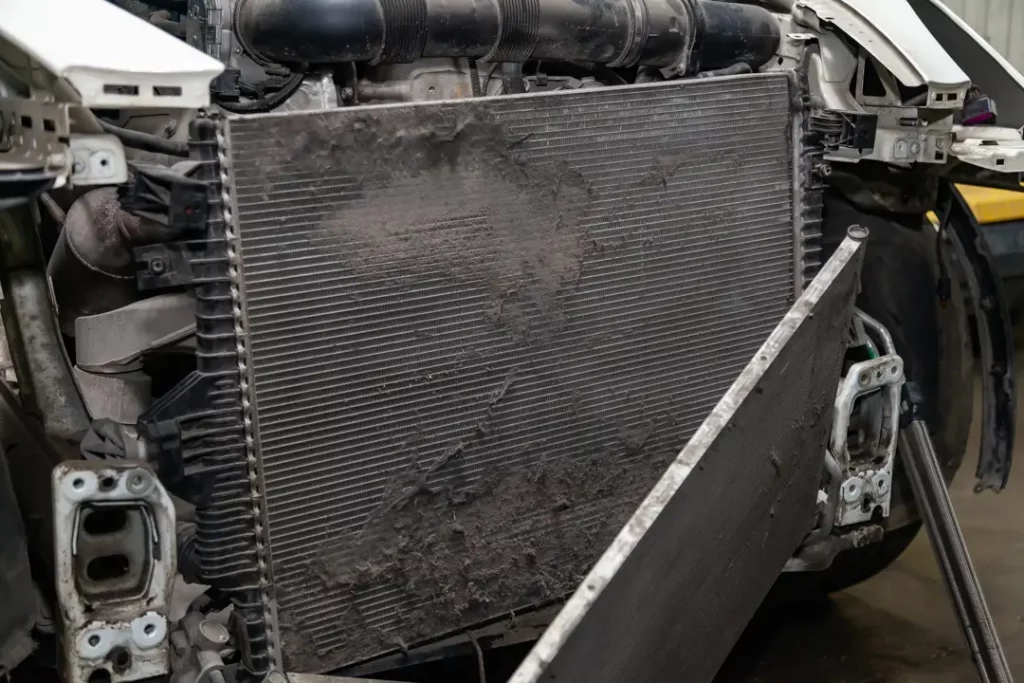
The condenser, located at the front of your car behind the grille, cools down the hot refrigerant gas into a cooler liquid. A broken or dirty condenser or component (like the condenser fan or condenser coil) can prevent this heat exchange, causing the refrigerant to remain hot. You might find that dirt or debris blocking airflow or physical damage can be the culprits.
How can you tell if you have a faulty condenser:
- Warm air when idling: You might notice that AC blows warm air while the car is not moving, but does cool down again when you start to move.
- Visual inspection: Have a look at the condenser and you might see debris blocking it or a condenser fan with bent fins caused by a minor collision.
The condenser converts hot refrigerant gas into a cooler liquid. A blocked or broken condenser keeps the refrigerant hot, leading to hot air from the vents.
Electrical issues
Your car’s air conditioning system relies on a network of electrical connections to function. Frayed cables, a blown fuse, or faulty sensors can disrupt the flow of electricity, leading to a complete system failure. For example, if the compressor’s electromagnetic clutch doesn’t engage, the refrigerant won’t circulate, and the AC won’t cool the air.
How to tell if car air conditioning blowing warm air is down to problems with the electrical system:
- Intermittent cooling: You might find that your AC only works sporadically.
- Non-functioning AC components: Certain parts of the AC system do not operate, such as the fan or compressor not engaging.
Electrical connections and sensors are vital for the AC’s operation. An electrical issue, like faulty wiring or components, can disrupt the system, preventing effective cooling.
Faulty compressor
The compressor pressurizes the refrigerant and circulates it. A faulty compressor means the refrigerant can’t be moved efficiently, which halts the cooling process. Compressor failure issues can range from mechanical failures to problems with the drive belt or clutch.
Here are some common signs and symptoms that you have a broken compressor:
- Warm air despite working fans: If you notice that your fans are blowing as normal, but there’s no cool air coming out.
- Noisy operation: You might notice that a bad compressor makes unusual noises.
The compressor pressurizes and circulates the refrigerant. If it fails, the refrigerant cannot move through the system, and the AC starts blowing hot air.
Clogged air filter
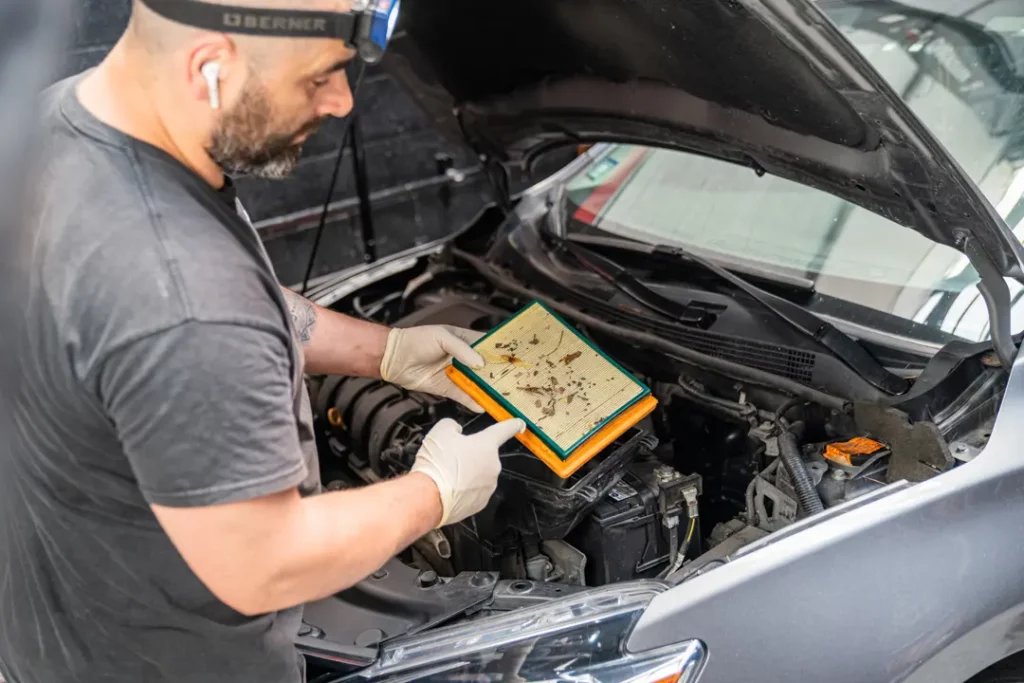
Sometimes, the problem isn’t with the AC system itself but with the air distribution components. A clogged or dirty air filter can restrict airflow into your car, making it seem like the AC is blowing hot air. This can happen if you drive in high-pollution areas or don’t replace the filter regularly.
How to know if you have a problem with your cabin filter:
- Weak airflow: You might feel that air from the vents feels weak or restricted.
- Dirty or polluted air: If you notice the AC blowing dirty air this could be down to a blocked and dirty filter.
A clogged air filter restricts airflow, causing the AC to blow out hot air. It’s a common issue in high-pollution areas or due to infrequent filter replacement.
Low refrigerant level
We already mentioned a refrigerant leak as a reason for your air conditioning blowing warm air, but low refrigerant levels can occur due to slow leaks over time. When the refrigerant level is low, the system can’t absorb and expel heat effectively, resulting in hot air blowing from the vents. Simply adding more refrigerant can be a temporary fix, but finding and repairing the leak is crucial for long-term reliability.
How to know if you have low levels of refrigerant:
- Gradual loss of cooling: You’ll notice that the AC gradually loses its cooling efficiency over time.
- Warm air: Even if you have your AC on the lowest temperature you still feel warm air coming out from the vents.
Low refrigerant levels, often due to slow leaks, mean the system cannot absorb and dissipate heat effectively. This leads to warm air from the vents.
A/C system maintenance
Like with many other parts of your car, regular maintenance of your car’s AC system is essential for keeping it working properly, and to avoid costly repairs in the long term. Here are some key maintenance practices to keep your AC system in top shape.
Visual inspection
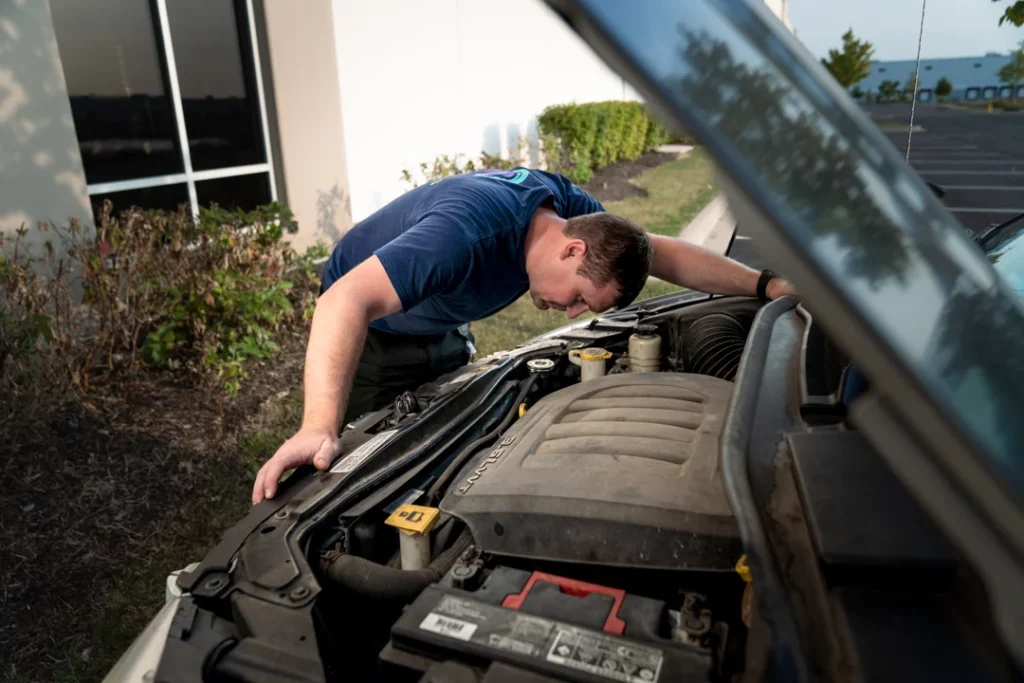
This is an easy thing to do on a regular basis. You might need to check your owner’s manual to identify all the components first, but once you’ve got that, open up your hood at take a look at your AC components.
Steps:
- First, check the condenser and radiator area. Look for a buildup of dirt, leaves, and other debris between the condenser and radiator. Then you can clean the area if needed.
- Then, inspect the condenser fins to make sure they aren’t damaged. Damaged fins might need straightening or, in some cases, the whole faulty condenser may need replacing.
Electrical components
You will need to check your vehicle manual again to make sure you know which parts of the electrical system to check.
Steps:
- You should inspect the wiring as well as connectors to sensors and switches for secure, clean connections. Look out for corrosion or loose connections, as these can cause intermittent issues.
- Check the electric engine cooling fan with the AC system on MAX cooling. When it’s on maximum the electric cooling fan should activate and if this is not happening as expected, it will require further investigation.
System performance test
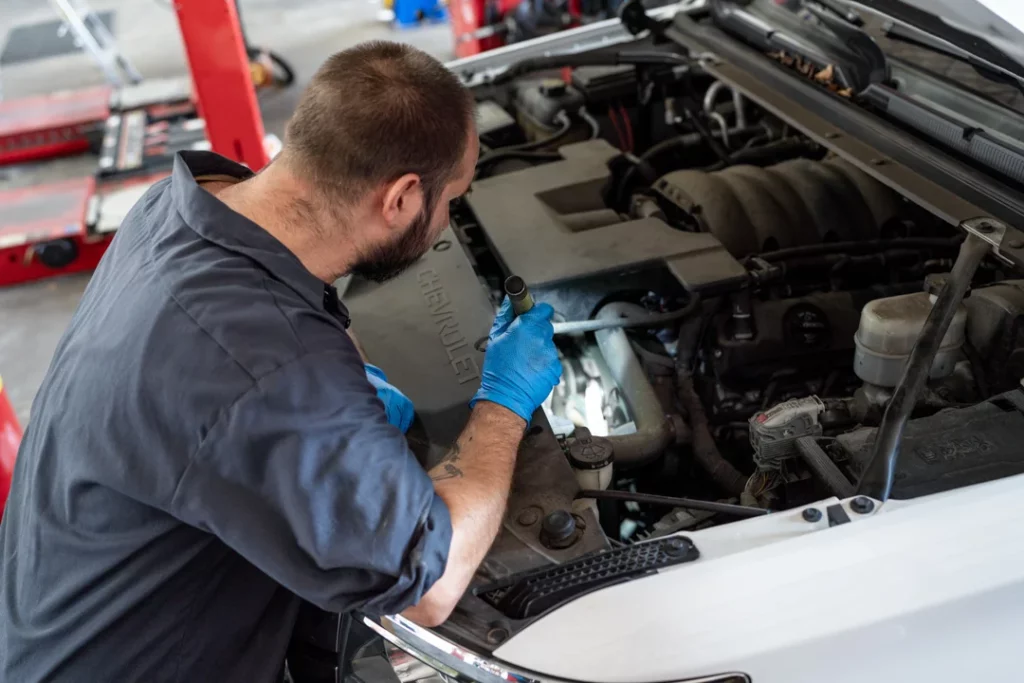
These checks will make sure the overall system is functioning correctly, and your compressor belt is in good condition.
Steps:
- To check if the overall system is working well, start the engine and let it warm up. Then, switch the temperature control to the full heat position and check the airflow and heat in all fan positions. Then, switch to defrost mode to check airflow. Finally, move to the AC position to check for cool air and notice any abnormal noises or smells when the compressor clutch engages.
- You should also check the compressor’s drive belt condition and tension. Look for oil leakage and belt slippage around the compressor clutch.
Refrigerant check
You can also check to make sure you have sufficient refrigerant and that it’s not leaking.
Steps:
- First, check for leaks by looking for an oily film around fittings. This is an indication of refrigerant leaks. Common leak points include the compressor to condenser, condenser to evaporator, and evaporator to compressor connections.
- Check your refrigerant levels and if the refrigerant level is low, it’s typically due to a leak that needs to be repaired. You can then refill the system with the appropriate type of refrigerant after fixing any leaks.
Air filters
This is one of the easiest maintenance steps.
Steps:
- You can replace dirty air filters if your vents are blowing weakly, as it might be due to a dirty filter. Regularly replacing your car’s cabin air filter, especially if you drive in high-pollution areas, will keep your AC system blowing clean, cold air.
Professional maintenance
If these maintenance steps seem a bit overwhelming, don’t worry. You can always visit a mechanic for both routine servicing and specialized repairs.
We recommend that you have your car’s air conditioner system serviced at least once a year. Professional servicing can help spot potential issues early and carry out complex tasks like flushing the system or replacing the compressor.
If you think you have a more serious problem, like a faulty compressor or a major refrigerant leak, rely on professional mechanics who have the necessary tools and knowledge to fix these problems quickly and reliably.
Safety precautions
If you do decide to work on your car air conditioning system yourself, always take the proper safety precautions:
- Wear protective gear: Always wear eye protection, gloves, and appropriate clothing when working around the AC system, especially with refrigerants.
- Handle refrigerants safely: Avoid exposing refrigerants to high temperatures or open flames, and never mix different types of refrigerants together.
By following these maintenance steps and safety precautions, you can help ensure your car’s AC system remains efficient and reliable.
Frequently Asked Questions
How to fix car AC not blowing cold air?
If your car’s AC isn’t blowing cold air, start by checking the simplest things first: ensure the AC is turned on and set to the coldest setting, then inspect the fuses and relays related to the AC system. Next, check the refrigerant level; if it’s low, you might have a leak that needs fixing, which a professional mechanic should handle. Also, check the condenser for debris and clean it if necessary, as well as the cabin air filter, which could be clogged and blocking airflow. If these steps don’t resolve the issue, it could be a more serious problem with the compressor or electrical components, so it’s best to take your car to a trained mechanic who can properly repair it.
What would cause an AC to blow hot air?
If your car’s AC is blowing hot air, it could be due to several issues: low refrigerant levels, usually from a leak; a broken or dirty condenser that’s preventing heat from dissipating; electrical problems disrupting the system’s function; a faulty compressor that’s not circulating refrigerant properly; or a clogged air filter blocking airflow. Checking these components can help identify the problem, and while some fixes are simple, like replacing the air filter, others might require a professional mechanic’s attention to get your AC back to blowing cool air.
How much to recharge a car AC?
Recharging your car’s AC professionally usually costs between $100 and $600, depending on your location and the make and model of your vehicle. This service involves adding refrigerant to your AC system, which can deplete over time or due to leaks. Some places may offer lower prices, but it’s important to ensure the service includes checking for leaks and ensuring the system is in good working order. Always go to a reputable mechanic to make sure the job is done right, and your AC runs efficiently.
Can a bad thermostat cause AC to blow warm air in car?
Yes, a bad thermostat can cause your car’s air conditioning to blow warm air. The thermostat regulates the temperature of the cooling system, so if it’s not working properly, you might get hot air blowing into your car. If you notice hot air from your AC and suspect the thermostat, it’s a good idea to have it checked and possibly replaced.
Share the Knowledge
